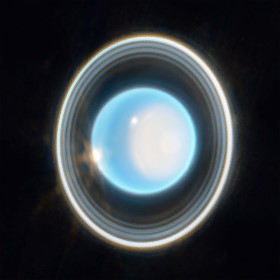|
Webb scores ringed world with an image of Uranus and a halo enveloping the planet
Uri Lachish, Rehovoth, Israel

Abstract
a halo, observed in Uranus image captured with NASA's James Webb Space Telescope, indicates a layer of
icy crystallites enveloping the planet.
NASA's James Webb Space Telescope captured images of Uranus and its rings, Fig-1 (1). In addition to the rings, a halo enveloping the planet is observed. A similar halo is observed in the Neptune images. Although
not mentioned explicitly, the photos seem to be taken in the opposition configuration, where the
light source, the sun, is at the back of the observing camera and the scattered light from the
image is reflected 180o back to it.

Fig-1: Uranus halo and rings captured with Webb Space Telescope (1).
Scattering from solid material is mainly Mie Scattering with a strong and sharp peak in the backward
direction, while scattering from gaseous material, like our blue sky, is wide-angle
Rayleigh scattering. Thus, during opposition, the solid rings glow brilliantly relative
to the light from the gaseous surface of the planet. This opposition effect is observed
beautifully with the glowing rings of Saturn Fig-2 (2).

Fig-2: Saturn rings observed in and out of opposition (2).
The halo of Uranus indicates a solid layer enveloping the planet, probably a layer of icy crystallites
that float on its dense atmosphere, where the weight density of an ice crystallite is similar
to the density of the gaseous atmosphere. The circular halo, in contrast to the elliptic
rings, tells that the particles are all over the planet surface.
References
-
https://www.nasa.gov/feature/goddard/2023/nasa-s-webb-scores-another-ringed-world-with-new-image-of-uranus
-
https://www.planetary.org/space-images/opposition-surge-of-saturns-rings
Webb scores ringed world with an image of Uranus and a halo enveloping the planet
On the net: April 2023
|